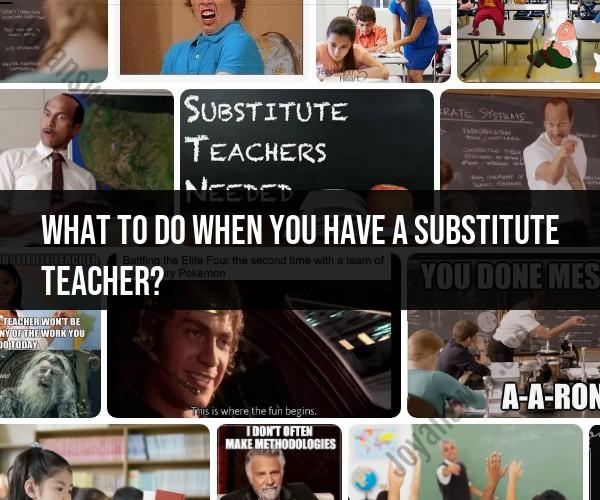What to do when you have a substitute teacher?
Managing a classroom with a substitute teacher requires careful planning and clear communication to ensure a smooth and productive learning environment. Here are some guidelines for both students and regular teachers to follow when there is a substitute teacher:
For Students:
Respect the Substitute:
- Treat the substitute teacher with the same respect you would show your regular teacher. Follow their instructions and show courtesy.
Be Cooperative:
- Cooperate with the substitute and participate in class activities. Avoid disruptive behavior that can interfere with the learning process.
Follow Classroom Rules:
- Adhere to the classroom rules and guidelines set by the substitute teacher. This includes rules related to behavior, assignments, and any specific instructions provided.
Complete Assignments:
- Complete any assignments or tasks given by the substitute teacher. Make sure to submit work on time and follow the provided instructions.
Ask for Clarification:
- If you have questions or need clarification on instructions, don't hesitate to ask the substitute teacher. They are there to help you.
Help Maintain Order:
- Assist in maintaining a positive and orderly classroom environment. Encourage your peers to follow instructions and avoid disruptive behavior.
For Regular Teachers:
Provide Clear Instructions:
- Leave clear and detailed instructions for the substitute teacher. Include information about the day's schedule, lesson plans, and any special considerations.
Emergency Procedures:
- Inform the substitute about emergency procedures, including evacuation routes and any health or safety concerns related to specific students.
Class Roster and Seating Chart:
- Provide the substitute with a class roster and seating chart. This helps them learn students' names quickly and manage the classroom effectively.
Contact Information:
- Share your contact information in case the substitute needs to reach you for any reason. Include details about how you can be reached during the school day.
Materials and Resources:
- Ensure that all necessary materials, textbooks, and resources are easily accessible to the substitute. Clearly label any materials they may need for the day.
Behavior Expectations:
- Clearly communicate behavior expectations to the students in advance. Let them know that the substitute is in charge and that the same behavioral standards apply.
Special Considerations:
- Inform the substitute about any students with special needs or considerations. Provide guidance on how to support these students effectively.
Feedback and Follow-Up:
- If possible, provide feedback to the substitute teacher after their assignment. Share information about how well the class followed instructions and any outstanding issues.
Express Appreciation:
- Express gratitude to the substitute teacher for their service. Recognize and appreciate their role in maintaining continuity in the learning process.
By following these guidelines, both students and regular teachers contribute to a positive and effective learning experience in the presence of a substitute teacher. Clear communication and cooperation are key to a successful day in the classroom.
What guidelines or actions should students follow when there's a substitute teacher?
Having a substitute teacher can change the classroom dynamic, but that doesn't mean it has to be chaotic! Here are some guidelines and actions students can follow to ensure a smooth and productive learning experience with a substitute:
Respect and professionalism:
- Treat the substitute teacher with the same respect you would show your regular teacher. This includes addressing them appropriately, listening attentively, and following their instructions.
- Be professional in your behavior and language. Avoid disruptive actions, loud conversations, or disrespectful remarks.
- Remember, the substitute teacher is there to facilitate learning, just like your regular teacher. Treat them as a professional and valuable member of the classroom community.
Preparation and participation:
- Come to class prepared with your notebook, textbooks, and any necessary materials. This shows the substitute that you're ready to learn and take the class seriously.
- Actively participate in the lesson. Ask questions, offer helpful responses, and engage in discussions. Your participation can create a positive learning environment for everyone.
- Complete assigned work to the best of your ability. Even if the lesson plan is different from what you expected, put in your effort and strive to learn new things.
Communication and assistance:
- If you have any questions or need clarification on the lesson, don't hesitate to ask the substitute teacher. They might not be familiar with your usual class routine, so feel free to explain any specific procedures or expectations.
- Offer to help the substitute if needed. Whether it's setting up materials, distributing assignments, or helping other students, taking initiative can be a big help.
- If you have any concerns or issues during the class, speak to the substitute respectfully or privately. They're there to guide and support you, just like your regular teacher.
Additional tips:
- Be patient and understanding. Substitute teachers might need some time to adjust to the class and establish routines.
- Be mindful of the classroom environment. Keep the noise level down and avoid distractions so everyone can learn effectively.
- Remember, your behavior reflects on the entire class. Make the substitute experience positive and enjoyable for everyone.
By following these guidelines and actions, students can contribute to a positive and productive learning environment when there's a substitute teacher. Remember, communication, respect, and active participation are key to making the most of this learning opportunity.
I hope this helps! Let me know if you have any other questions.












